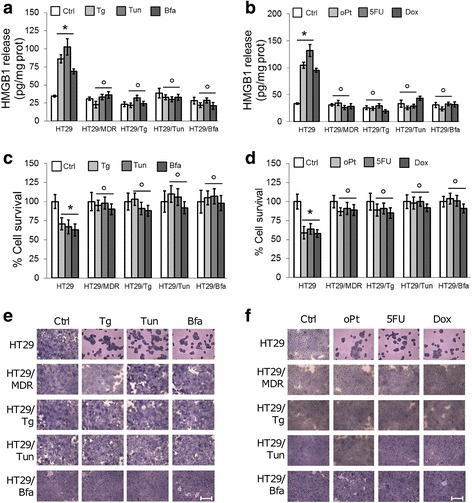Fig. 1.

Drug resistance of human colon cancer cells adapted to ER stress. a, b. Release of the necrosis marker HMGB1 to culture media of the indicated cells (human chemosensitive HT29 cells, chemoresistant HT29/MDR cells, ER stress-resistant clones HT29/Tg, HT29/Tun, HT29/Bfa), following incubation in fresh medium (Ctrl), or in media containing: thapsigargin (Tg), tunicamycin (Tun), brefeldin A (Bfa), oxaliplatin (oPt), 5-fluorouracil (5FU), doxorubicin (Dox), as indicated in Methods. Data are mean ± SD. (n = 3). *p < 0.001 for treated cells vs. Ctrl HT29 cells. °p < 0.001 for HT29/MDR, HT29/Tg, HT29/Tun/HT29/Bfa cells vs. the corresponding condition in HT29 cells. c, d. Viability of cells measured by Neutral red staining. Data are mean ± SD (n = 4). *p < 0.02 for treated cells vs. Ctrl HT29 cells; °p < 0.05 for HT29/MDR, HT29/Tg, HT29/Tun/HT29/Bfa cells vs. the corresponding condition in HT29 cells. e, f. Crystal violet staining of cells grown in 96-well plates and treated as in a and b. The images are representatives of at least 5 microscopic fields showing similar cell density. Bars = 500 μM
